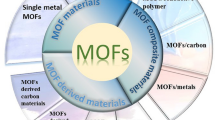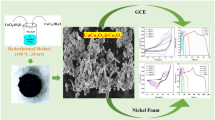Abstract
Due to its excellent performance, Co3O4 are redeemed as a promising supercapacitor material. However, problems like its low ion diffusion speed limit its application. In this paper, by preparing composite materials of Co3O4 and Zn(OH)F, the ion diffusion path of Co3O4 material is extended and the electrochemical performance of the material is enhanced. The composite material grown in situ on nickel foam was synthesized by hydrothermal method, and the optimum experimental route was determined through the selection of zinc and cobalt sources and the optimization of hydrothermal conditions and calcination conditions. When the current density is 1 mA/cm2, the capacity of Co3O4@Zn(OH)F composite material is as high as 5.68 F/cm2, showing relatively stable electrochemical performance, this is because the addition of Zn(OH)F material extends the diffusion path of ions. Subsequently, the physical properties of the composite material with good performance were characterized. The XRD tests showed that the synthesized material was composed of Co3O4 and Zn(OH)F, with high crystallinity and no other impurity peaks. Through SEM analysis, there are nanowire and spheroidal structures that can be found in the micro scale, and the nanowires are interwoven with each other to form snowflake shape, which can provide more transfer paths for charge transfer. The EDS test and element analysis show that all elements are evenly distributed. According to the result of the XPS test, the valence states of each element in the material coincide with those of Co3O4 and Zn(OH)F. The FT-IR test showed that the presence of Zn(OH)F did not affect the structure of Co3O4 material. In conclusion, by adopting the synthesis method described in the text, the ion diffusion performance of Co3O4 is improved, which also proves the possibility of its industrial application as supercapacitor material.













Similar content being viewed by others
References
Khan K, Tareen AK, Aslam M et al (2020) Going green with batteries and supercapacitor: two dimensional materials and their nanocomposites based energy storage applications. Prog Solid State Chem 58:100254
Chen X, Wang XL, Jiang DM et al (2020) Sulfur-doped ZIF-derived Co3O4 flower-like microstructures for high stability supercapacitors. J Alloys Compd 831:154772
Yadav S, Devi A (2020) Recent advancements of metal oxides/nitrogen-doped graphene nanocomposites for supercapacitor electrode materials. J Energy Storage 30:101486
Fang J, Kang CX, Fu LK et al (2020) Fabrication of hollow bamboo-shaped NiCo2O4 with controllable shell morphologies for high performance hybrid supercapacitors. J Alloys Compd 849:156317
Wei C, Zhang R, Zheng X et al (2018) Hierarchical porous NiCo2O4/CeO2 hybrid materials for high performance supercapacitors. Inorg Chem Front 5(12):3126–3134
Wei C, Chen Q, Cheng C et al (2019) Mesoporous nickel cobalt manganese sulfide yolk–shell hollow spheres for high-performance electrochemical energy storage. Inorg Chem Front 6(7):1851–1860
Wei C, Sun J, Zhang Y et al (2022) Hierarchical Ni(OH)2–MnO2 hollow spheres as an electrode material for high-performance supercapacitors. Inorg Chem Front 9(14):3542–3551
Shi Z, Liu Y, Zhang Y et al (2023) Designed synthesis of yolk-shelled NiCo2O4/MnCo2O4 hollow sphere with boosted performance for supercapacitors. Appl Surf Sci 611:155758
Guan Q, Cheng J, Wang B et al (2014) Needle-like Co3O4 anchored on the graphene with enhanced electrochemical performance for aqueous supercapacitors. ACS Appl Mater Interfaces 6:7626–7632
Zhou C, Zhang Y, Li Y et al (2013) Construction of high-capacitance 3D CoO@ polypyrrole nanowire array electrode for aqueous asymmetric supercapacitor. Nano Lett 13(5):2078–2085
Lu C, Liu L, Yang Y et al (2023) Recent progress in Co3O4-based nanomaterials for supercapacitors. Chem Nano Mat e202200537
Hu X, Wei L, Chen R et al (2020) Reviews and prospectives of Co3O4-based nanomaterials for supercapacitor application. ChemistrySelect 5(17):5268–5288
Yang Y, Chen X, Cao Y et al (2020) Synthesis of homogeneous hollow Co3O4 microspheres for enhanced cycle life and electrochemical energy storage performance. Chem Electro Chem 7(3):723–729
Chang Z, Dou H, Ding B et al (2017) Co3O4 nanoneedle arrays as a multifunctional“super-reservoir” electrode for long cycle life Li-S batteries. J Mater Chem A 5:250–257
Deng J, Kang L, Bai G et al (2014) Solution combustion synthesis of cobalt oxides (Co3O4 and Co3O4/Co O) nanoparticles as supercapacitor electrode materials. Electrochim Acta 132:127–135
Hao JX, Peng SL, Qin TF et al (2017) Fabrication of hybrid Co3O4/NiCo2O4 nanosheets sandwiched by nanoneedles for high-performance supercapacitors using a novel electrochemical ion exchange. Sci China Mater 60(12):1168–1178
Li MG, Yang WW, Huang YR et al (2018) Hierarchical mesoporous Co3O4@ZnCo2O4 hybridnanowire arrays supported on Ni foam for high performance asymmetric supercapacitors. Sci China Mater 61(9):1167–1176
Yang S, Liu Y, Hao Y et al (2018) Oxygen-vacancy abundant ultrafine Co3O4/graphene composites for high-rate supercapacitor electrodes. Adv Sci 5(4):1700659
Liu T, Zhang L, You W et al (2018) Core–shell nitrogen-doped carbon hollow spheres/Co3O4 nanosheets as advanced electrode for high-performance supercapacitor. Small 14(12):1702407
Zhu M, Chen Q, Kan J et al (2019) Cobalt oxide nanoparticles embedded in N-doped porous carbon as an efficient electrode for supercapacitor. Energy Technol 7(4):1800963
Dong X, Xu H, Wang X et al (2012) 3D Graphene-cobalt oxide electrode for high-performance supercapacitor and enzymeless glucose detection. ACS Nano 6(4):3206–3213
Liang K, Tang X, Hu W et al (2012) High-performance three-dimensional nanoporous NiO film as a supercapacitor electrode. J Mater Chem 22(22):11062–11067
Ghodbane O, Louro M, Coustan L et al (2014) Microstructural and morphological effects on charge storage properties in MnO2-carbon nanofibers based supercapacitors. J Electrochem Soc 160(11):2315–2321
Xu J, Li L, Gao P et al (2015) Facile preparation of NiCo2O4, nanobelt/graphene composite for electrochemical capacitor application. Electrochim Acta 166(7):206–214
Han E, Han Y, Zhu L et al (2018) Polyvinyl pyrrolidone assisted synthesis of flower-like nickel-cobalt layered double hydroxide on Ni foam for high-performance hybrid supercapacitor. Ionics 24(9):2705–2715
Xu R, Zeng HC (2004) Self-generation of tiered surfactant superstructures for one-pot synthesis of Co3O4 nanocubes and their close and non-close-packed organizations. Langmuir 20(22):9780–9790
Author information
Authors and Affiliations
Contributions
Ling Li contributed to the experimental process and data analysis; Jiyao Zhou was involved in original draft preparation and editing; Xinbin Pei and Yanwei Zhang contributed to the physical characterization of materials. All the authors have read and agreed to the published version of the manuscript.
Corresponding author
Ethics declarations
Ethics approval
This article does not contain any studies with human participants or animals performed by any of the authors.
Competing interests
The authors declare no competing interests.
Additional information
Publisher’s note
Springer Nature remains neutral with regard to jurisdictional claims in published maps and institutional affiliations.
Rights and permissions
Springer Nature or its licensor (e.g. a society or other partner) holds exclusive rights to this article under a publishing agreement with the author(s) or other rightsholder(s); author self-archiving of the accepted manuscript version of this article is solely governed by the terms of such publishing agreement and applicable law.
About this article
Cite this article
Li, L., Zhou, J., Pei, X. et al. Preparation and performance study of snowflake shape Co3O4@Zn(OH)F supercapacitor composite materials by in situ growth hydrothermal method. Ionics 29, 3303–3316 (2023). https://doi.org/10.1007/s11581-023-05025-8
Received:
Revised:
Accepted:
Published:
Issue Date:
DOI: https://doi.org/10.1007/s11581-023-05025-8




